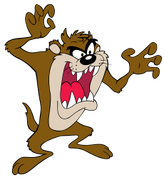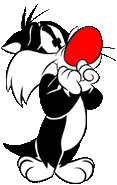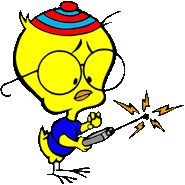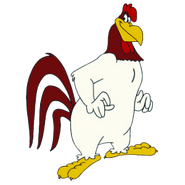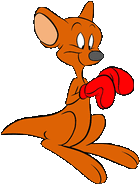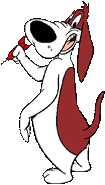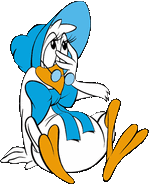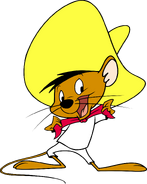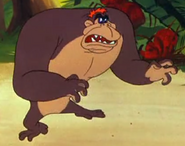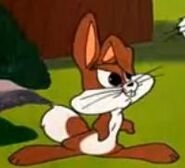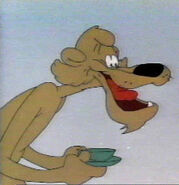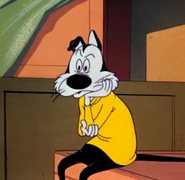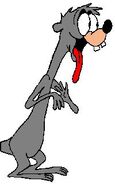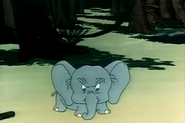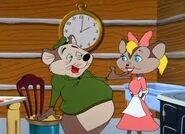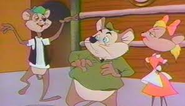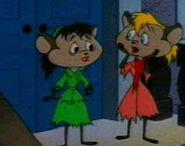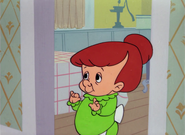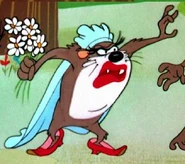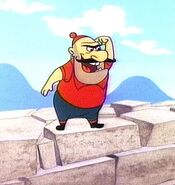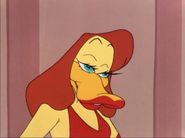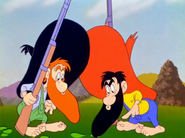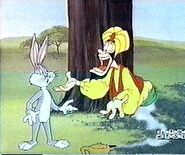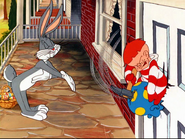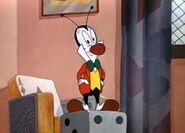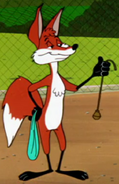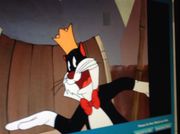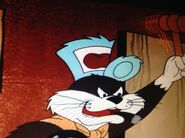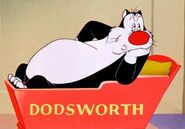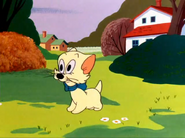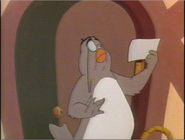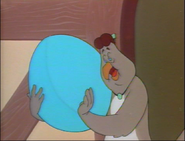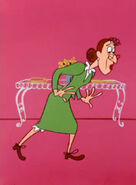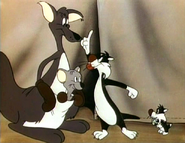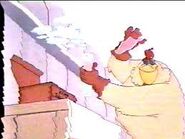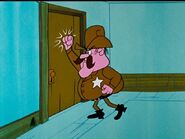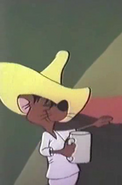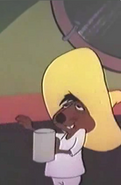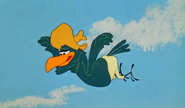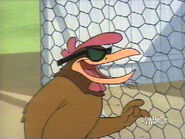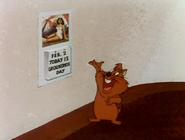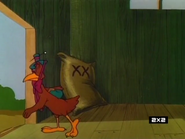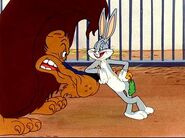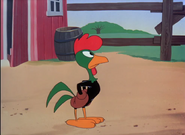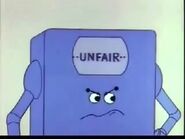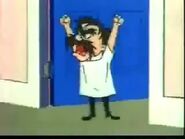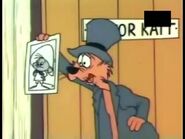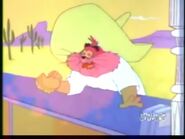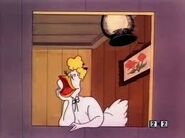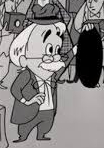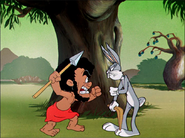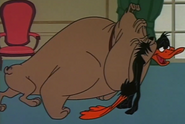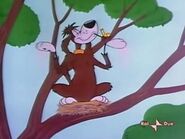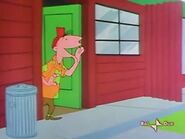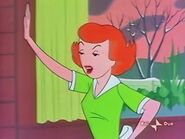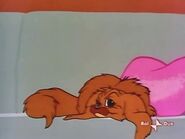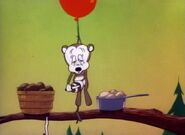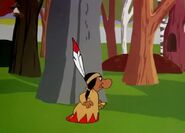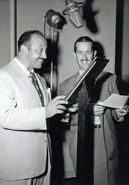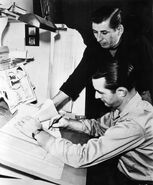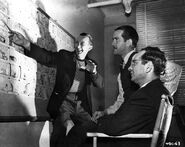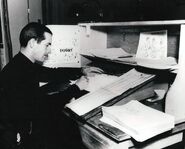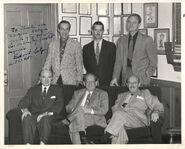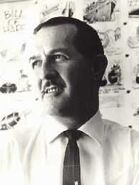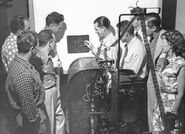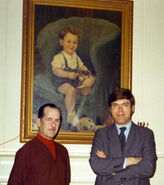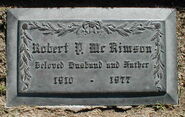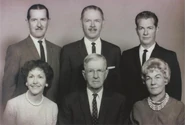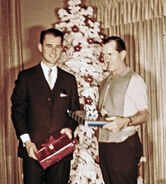Robert Porter McKimson, Sr. (13 October 1910 - 29 September 1977) was an American animator, illustrator, and director best known for his work on the Looney Tunes and Merrie Melodies series of cartoons from Warner Bros., and later DePatie-Freleng Enterprises. He was also well known for defining Bugs Bunny's look in 1943.
Career[]
Born in Denver, Colorado, McKimson spent ten years getting an art education. He then went to work for Walt Disney. He stayed with Disney's studio for two years and then went to work for the Romer Grey Studio located in Altadena, California, a would-be animation shop started by the son of Western author Zane Grey, and financed by Zane Grey's wife. Several cartoons were animated at the Romer Grey Studio, but due to the ruin of Grey's fortunes after the Wall Street Crash of 1929, none were ever released. Most never made it to camera.
After the Romer Grey Studio shut down, McKimson was hired by Hugh Harman and Rudolf Ising, first doing the ink-and-paint duties for the very first Looney Tunes, then becoming an inbetweener before becoming an animator by 1931. At that time he had an accident that gave him a concussion. As a result, he was able to visualize better, thus increasing his production and animation. He was the head animator and go-to guy in the late 1930s at the studio, which overwhelmed him. Eventually he worked exclusively with Bob Clampett. [1] He was offered a directorial position by Leon Schlesinger in 1937, but declined, allowing the position to go to animator Chuck Jones.[1] He accepted his own directorial position in 1944, when Frank Tashlin left Warner Bros. to direct live-action films.[2]
McKimson created characters like Foghorn Leghorn and the Tasmanian Devil, as well as directing every Hippety Hopper/Sylvester pairing. He also created Speedy Gonzales for the 1953 short Cat-Tails for Two and directed many others periodically (along with Freleng and other directors) for the remainder of his theatrical career.

A still from the 1950 Hippety Hopper/Sylvester short "Pop 'Im Pop!" This cartoon also introduced Sylvester's son, Sylvester Junior.
McKimson's first directorial work, "Daffy Doodles" (at least his first released directorial work; he cut his actual directorial teeth on a Seaman Hook wartime cartoon for military audiences in 1944), wherein Daffy draws moustaches on all the pre-drawn (and even some natural) faces in his sight, was released in early April 1946.
In 1953, the Warner Bros. cartoon studio laid off most of its staff for a period of six months. After the studio reopened, Freleng and Jones quickly re-assembled their respective units, but McKimson discovered every member of his previous team, apart from Tedd Pierce and background painter Dick Thomas, refused to work with him again, including his own brother Charles McKimson. At the start of this period, McKimson animated on three of his own shorts, The Hole Idea, Dime to Retire, and Too Hop to Handle. (in fact, he was the sole animator credited on The Hole Idea) [3] Soon, McKimson assembled a new team of artists, including layout man/background painter Robert Gribbroek and animators Warren Batchelder, Ted Bonnicksen, and George Grandpré. Tom Ray, Russ Dyson, and Keith Darling helped at various points.
Later Career[]
McKimson soldiered on at Warner's cartoon studio as it began to lose people (including Jones) in 1962. Over this time, he directed his share of shorts and worked on the feature The Incredible Mr. Limpet. After the studio closed, he joined DePatie-Freleng Enterprises, co-owned by his old associate Friz Freleng and David H. DePatie, who had been a producer at the Warners studio. At DePatie-Freleng, McKimson directed several The Inspector shorts and worked on some of the Looney Tunes and Merrie Melodies contracted out to DePatie-Freleng by Warner Bros. In 1967, Warner opened its animation studio again; McKimson went back in 1968 and stayed until the animation studio shut down again in 1969. His last Warner Bros. cartoon was "Injun Trouble" with Cool Cat. "Injun Trouble" was also the last of the original Looney Tunes or Merrie Melodies cartoons to be produced before the Warner Bros. cartoon studio was closed. McKimson was the only person to be at the studio from the start of the Looney Tunes series through its finish in 1969, first as an inker, and then as a director.
In 1972, he went back to DePatie-Freleng to direct The Pink Panther Show shorts, among their other series.
Death[]
McKimson died from a heart attack while eating lunch with Friz Freleng and David H. DePatie at the age of 66. A few days earlier, he had been given a clean bill of health during a physical. During the physical, his doctor suggested his family history (his father lived to be 100 years) would allow him to live many more years.[4]
Personal Life[]
McKimson was a skilled horseman and polo player, a dedicated bowler, and a Master Mason. He had two brothers: Charles McKimson (the younger) and Tom McKimson (the older), who also worked as animators.[1] Charles was frequently part of McKimson's unit at Warner Bros.
Characters Created[]
Gallery[]
Looney Works[]
Director[]
See List of cartoons supervised by Robert McKimson
Animator[]
- A-Lad-In Bagdad
- Acrobatty Bunny
- All This and Rabbit Stew
- Aloha Hooey
- Along Flirtation Walk
- Any Bonds Today?
- Aviation Vacation
- Baby Bottleneck
- The Bashful Buzzard
- The Bear's Tale
- Birdy and the Beast
- Booby Traps
- Book Revue
- Bosko in Person
- Bosko the Drawback
- Bosko's Dizzy Date
- Bosko's Knight-Mare
- Bosko's Store
- Boulevardier from the Bronx
- Buckaroo Bugs
- Buddy and Towser
- Buddy's Adventures
- Buddy's Bug Hunt
- Buddy's Circus
- Bugs Bunny Gets the Boid
- The Cagey Canary
- A Cartoonist's Nightmare
- The Cat Came Back
- Ceiling Hero
- Circus Today
- Coal Black and de Sebben Dwarfs
- The CooCoo Nut Grove
- A Corny Concerto
- Country Boy
- Cracked Ice
- The Crackpot Quail
- Crazy Cruise
- The Curious Puppy
- Daffy Duck and the Dinosaur
- Dime to Retire
- The Dish Ran Away with the Spoon
- Dog Daze
- Dog Gone Modern
- Draftee Daffy
- Easter Yeggs
- Elmer's Candid Camera
- Elmer's Pet Rabbit
- Falling Hare
- Farm Frolics
- Fighting Tools
- The Fire Alarm
- Fish Tales
- Foxy by Proxy
- Ghost Wanted
- The Girl at the Ironing Board
- Goin' to Heaven on a Mule
- The Good Egg (Merrie Melodies)
- Good Night Elmer
- The Great Piggy Bank Robbery
- A Gruesome Twosome
- Hare Ribbin'
- The Haunted Mouse
- Have You Got Any Castles?
- The Heckling Hare
- The Hep Cat
- His Hare Raising Tale
- The Hole Idea
- Hollywood Steps Out
- Horton Hatches the Egg
- I Haven't Got a Hat
- An Itch in Time
- Jasper Goes Hunting
- The Lady in Red
- Lady, Play Your Mandolin!
- Land of the Midnight Fun
- Let It Be Me
- Little Brother Rat
- The Little Lion Hunter
- Little Pancho Vanilla
- Mighty Hunters
- My Little Buckaroo
- The Night Watchman
- Now That Summer Is Gone
- Of Fox and Hounds
- Old Glory
- The Old Grey Hare
- One Meat Brawl
- Page Miss Glory
- Pigs Is Pigs
- Prest-O Change-O
- Robin Hood Makes Good
- Russian Rhapsody
- September in the Rain
- Shake Your Powder Puff
- She Was an Acrobat's Daughter
- Sniffles and the Bookworm
- Sniffles Bells the Cat
- Sniffles Takes a Trip
- Snowman's Land
- A Star Is Hatched
- Sunday Go to Meetin' Time
- Sweet Sioux
- A Tale of Two Kitties
- Tokyo Woes
- Tom Thumb in Trouble
- Too Hop to Handle
- Tortoise Beats Hare
- Tortoise Wins by a Hare
- Toy Town Hall
- The Wacky Wabbit
- Wacky Wild Life
- Wagon Heels
- What's Cookin' Doc?
- When I Yoo Hoo
- Why Do I Dream Those Dreams
- A Wild Hare
- The Wise Quacking Duck
- You're an Education
Writer[]
- Banty Raids (with Nick Bennion)

